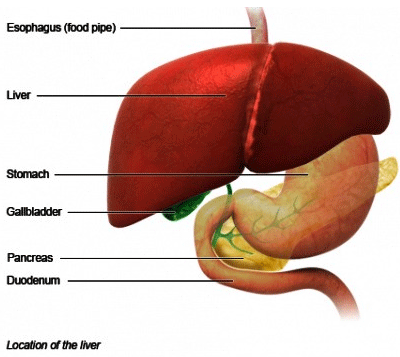Describe the Structure and Function of Liver
Your liver is divided into sections called lobes. Its a huge organ that sits roughly in the middle of your abdomen.

Human Liver Functions Human Liver Medical Knowledge Human Anatomy And Physiology
The liver also detoxifies potentially harmful chemicals.

. There is a falciform ligament that functions by separating the two different lobes. The hepatic artery which brings oxygenated blood from the dorsal aorta and. A hormone similar in molecular structure to insulin.
The Structure and Function of Liver Cells Biology The liver is the largest gland in the body. It removes toxins from the bodys blood supply maintains healthy blood sugar levels regulates blood clotting and performs hundreds of other vital functions. It consists of a right lobe which is comparatively larger and a smaller left lobe.
Hepatocytes bile canaliculi and hepatic sinusoids. The liver controls most chemicals in the body. The hepatic portal vein which brings blood rich in food materials form the gut.
The liver is made of very soft pinkish-brown tissues encapsulated by a connective tissue capsule. It is located beneath the rib cage in the right upper abdomen. You wouldnt live long without a functioning liver.
It plays a role in hematology with clotting factor and protein synthesis. The liver tissue of an alcoholic may become clogged with fats and adversely affect liver function. Please remember to answer to 2 of your classmates discussions on 2 separate days by Saturday.
It plays an important role in childhood growth and continues. The smallest of the two lobes. Bilirubin is formed by the breakdown of hemoglobin.
The liver is a roughly triangular organ that extends across the entire abdominal cavity just inferior to the diaphragm. The liver is protected from any physical. Structure of a liver lobule Blood enters into the liver lobules via the hepatic artery which then forms hepatic sinusoids that drain into the central vein.
The liver is a multilobulated gland. Structure and function of the liver. The liver is an intraperitoneal organ found inferior to the diaphragm and deep to the 7th to 11th ribs.
The liver is the storage location for fat-soluble vitamins and handles cholesterol homeostasis. Please remember to answer to 2 of your classmates discussions on 2 separate days by Saturday. The iron released from.
Your post should be at least 250 words. Structure of Liver The shape of a liver is considered triangular with a bilobed structure. The liver is your bodys chemical factory It takes the raw materials absorbed by the intestine and makes all the various chemicals your body needs to function.
The reply to your classmates should be at least 100 words each. Also called hepatic disease this is an umbrella term referring to damage to or disease of the liver. As much as three-quarters of the blood reaching the liver does so.
It stores iron and copper. The liver has three main components. The liver is a reddish spongy organ that occurs on the right side of the abdomen just below the diaphragm.
The location of the liver is such that you just cant miss it as it spans through three abdominal regions. Bile which helps in the digestion and absorption of fats vitamins and cholesterol is produced in. Structure of Liver.
Choose 1 of the following questions to answer by day 3 Wednesday and include 2 references. The first is called the hepatic artery and it supplies oxygen-rich blood from the heart to. This is the largest lobe.
It is a hugely important gland that is responsible for a wide range of metabolic and chemical reactions that are vital to living. The hepatic vein divides the right lobe into front and back sections. It breaks down and secretes many drugs that.
The major functions of the liver include. The liver is a triangular bilobed structure consisting of a larger right lobe and a smaller left lobe. The liver is a metabolically complex organ.
The Liver and Its Functions The liver is the largest solid organ in the body. Hepatocytes liver parenchymal cells perform the livers metabolic functions. These cells play a role in a wide variety of secretory metabolic and endocrine functions.
It is the largest exocrine gland of the body and weighs about 12 to 15 kg in adult men. The liver is supported in the abdominal cavity by a fold of the peritoneum. The liver plays a role in heme breakdown.
Filtration Digestion Metabolism and Detoxification Protein synthesis Storage of vitamins and minerals Lets explain and talk through the five major functions of the liver including how. Functions of the liver include. The reply to your classmates should be at least 100 words each.
A hepatocyte is the livers main cell type accounting for around 80 percent of the livers volume. Choose 1 of the following questions to answer by day 3 Wednesday and include 2 references. Your post should be at least 250 words.
This lobe is divided into four sections. Structure and function of the liver. A Complete Description of the Structure of the Liver.
Absorbing and metabolizing bilirubin. Resting directly on top of the liver. Bile helps the small intestine break down and absorb fats cholesterol and some vitamins.
Formation and excretion of bile as a component of bilirubin metabolism see Overview of bilirubin metabolism Regulation of carbohydrate homeostasis Lipid synthesis and secretion of plasma lipoproteins. It also has two big vessels going into it. The liver has the ability to.
Location and Structure of the Liver. Most of the livers mass is located on the right side of the body where it descends inferiorly toward the right kidney.

Liver Anatomy And Functions Johns Hopkins Medicine

The Liver Chart 22x28 Liver Anatomy Human Body Organs Anatomy Medical Anatomy

Liver Functions Location Anatomy And Disease Columbia Surgery
No comments for "Describe the Structure and Function of Liver"
Post a Comment